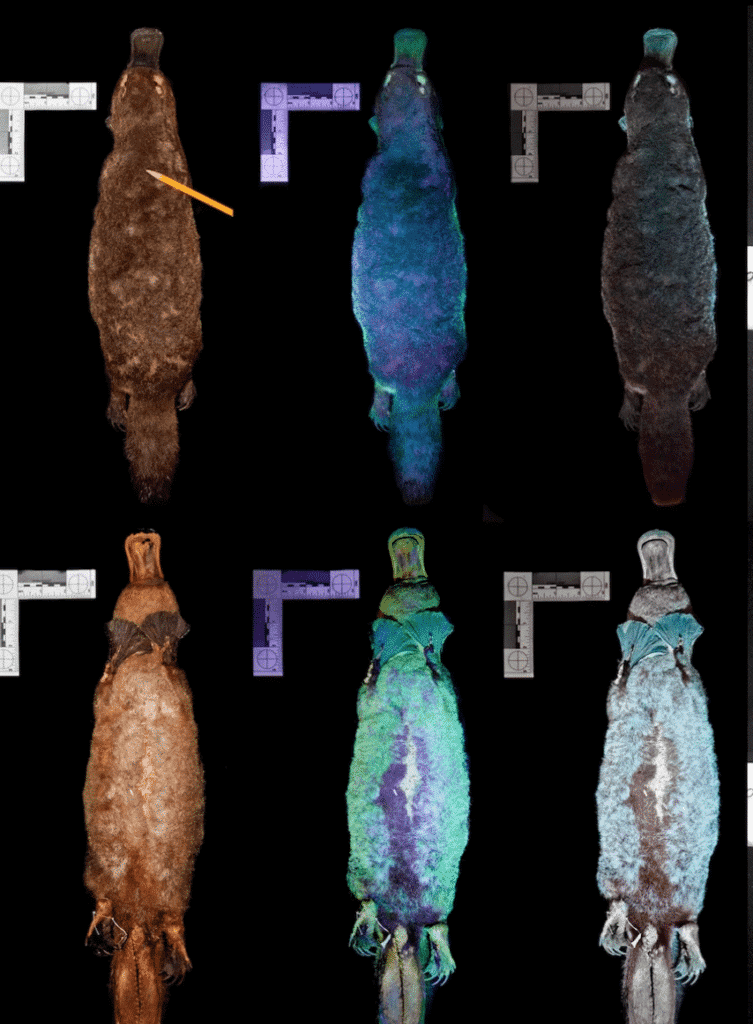When it comes to the eccentric wonders of the animal kingdom, few creatures rival the platypus in their unique charm and mystique. These egg-laying, venomous spined, and duck-billed mammals are already renowned for their otherworldly characteristics. But recent groundbreaking research has illuminated yet another astonishing facet of their existence: biofluorescent fur. In this article, we delve into the intriguing discovery that has scientists buzzing and raises questions about the role of this bizarre glow in the life of the platypus.
The Peculiar Platypus
Before we embark on the luminous journey of platypus biofluorescence, let’s get to know this remarkable animal a bit better. The platypus, endemic to Australia, is a creature that defies conventional categorization. While it is indeed a mammal, it boasts some astounding features that set it apart from its furry counterparts.
For starters, platypuses lay eggs, a trait typically associated with reptiles and birds, not mammals. Adding to their enigma, they possess venomous spines on their rear legs, a feature more akin to certain species of fish and insects. These semi-aquatic marvels are also endowed with beaver-like tails, which facilitate their aquatic locomotion, and duck-like bills, used for hunting prey while navigating the waterways of their native habitats, often with their eyes closed. It’s safe to say that platypuses are a living embodiment of evolutionary oddities.
Shedding Light on the Discovery: Platypus Biofluorescence
In a groundbreaking study published in the journal Mammalia, scientists have revealed the astonishing revelation that platypuses exhibit biofluorescence. But what exactly does this mean? Biofluorescence is a phenomenon where a substance, in this case, fur, absorbs light at one wavelength and emits it at a different wavelength, creating a vivid and captivating display of color.
When illuminated by ultraviolet (UV) light—a portion of the light spectrum invisible to the human eye—platypus fur emanates a mesmerizing blue-green glow. The lead author of the study, Paula Anich, expressed her astonishment at this discovery, noting that the platypus is already an incredibly unique animal. This newfound trait, however, expands our understanding of biofluorescence in the animal kingdom.
Biofluorescence: A Widespread Phenomenon
The platypus isn’t the only member of the animal kingdom to exhibit biofluorescence. In recent years, scientists have unearthed similar traits in various species, unveiling the hidden beauty of the natural world. From sea turtles with fluorescent shells to fungi and even flying squirrels, this remarkable phenomenon is far more prevalent than previously believed.
Although the exact reasons behind biofluorescence remain shrouded in mystery, scientists have proposed a range of hypotheses. Some suggest it could serve as a form of camouflage, helping these creatures blend into their environments. The revelation that flying squirrels emit a pink glow from their bellies under UV light further fueled curiosity and led to more explorations into this captivating area of research.
The Chicago Connection: A Surprising Discovery
The journey to unveil the platypus’s biofluorescent secret led scientists to Chicago’s Field Museum. Here, they conducted a fascinating experiment by illuminating preserved squirrel pelts with UV lights. To their astonishment, they decided to apply the same treatment to a platypus specimen stored at the museum—and witnessed the glow. This revelation was further corroborated by another research paper, published just before Anich’s study. It reported platypus found on an Australian road exhibited biofluorescence when exposed to blacklight—a type of UV light. This discovery established that living platypuses, not just long-deceased specimens, are almost certainly biofluorescent.
The Unanswered Question: Why Do Platypuses Glow?
Despite this remarkable discovery, the enigmatic question of why platypuses glow remains unanswered. Given that these creatures are predominantly nocturnal and keep their eyes closed while swimming, it’s unclear whether biofluorescence plays a pivotal role in communication among platypuses.
One plausible theory is that it serves as a form of camouflage, helping platypuses evade potential predators that can perceive UV light. By absorbing UV light and emitting blue-green light, they might effectively blend into their surroundings. This making them less conspicuous to animals such as big fish, birds of prey, and dingos, all of which are known to see in UV.
Alternatively, it’s conceivable that biofluorescence is a remnant from their ancestors that has endured alongside their more conspicuous features, such as egg-laying. This would mean that platypuses carry this unique trait as a relic of their evolutionary history, with no current functional purpose.
The Road Ahead: Unveiling the Biofluorescent Mysteries
The discovery of platypus biofluorescence has opened a new chapter in our understanding of these enigmatic creatures. Scientists remain captivated by the questions it raises and the potential insights it might provide into the lives of platypuses.
Both Paula Anich and platypus expert Gilad Bino are eager to conduct further research, hoping to observe a living platypus. So to confirm the existence of biofluorescence and shed light on its potential functions.
Conclusion: A Glowing Enigma
The platypus, with its egg-laying, venomous spines, and duck-like bill, has once again left scientists and nature enthusiasts in awe. The revelation of its biofluorescent fur adds another layer to the already perplexing tapestry of its existence. While the exact purpose of this glow remains a mystery, it serves as a reminder that nature’s secrets are boundless. Our quest for understanding is as bright as the blue-green glow of the platypus’s fur under the UV light.
As the scientific community delves deeper into the world of biofluorescence, the platypus stands as a symbol of the countless wonders waiting to be uncovered. Its biofluorescence is a testament to the enigmatic beauty of the animal kingdom.
Up next:
Rare White Platypus Spotted: A Phenomenal Discovery
Watch: Man Hand Feeding & Playing With A Friendly Platypus
Join our Forum for free today!

- The Kleptomaniac Cat That Rules Houston - July 20, 2024
- Elephant Makes a Lifelong Friend at Sanctuary in Tennessee - July 14, 2024
- Evidence For World’s Oldest Fossilized Forest Discovered in New York - July 11, 2024

